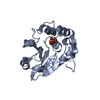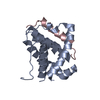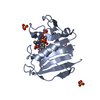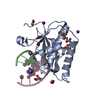[English] 日本語
 Yorodumi
Yorodumi- PDB-2rui: Solution Structure of the Bacillus anthracis Sortase A-substrate ... -
+ Open data
Open data
- Basic information
Basic information
| Entry | Database: PDB / ID: 2rui | |||||||||
|---|---|---|---|---|---|---|---|---|---|---|
| Title | Solution Structure of the Bacillus anthracis Sortase A-substrate Complex | |||||||||
 Components Components |
| |||||||||
 Keywords Keywords | HYDROLASE/HYDROLASE SUBSTRATE / Sortase / SrtA / Transpeptidase / HYDROLASE-HYDROLASE SUBSTRATE complex | |||||||||
| Function / homology |  Function and homology information Function and homology informationmembrane => GO:0016020 / cysteine-type peptidase activity / proteolysis / membrane Similarity search - Function | |||||||||
| Biological species |  synthetic (others) | |||||||||
| Method | SOLUTION NMR / simulated annealing | |||||||||
| Model details | lowest energy, model1 | |||||||||
 Authors Authors | Chan, A.H. / Yi, S. / Jung, M.E. / Clubb, R.T. | |||||||||
 Citation Citation |  Journal: J.Biol.Chem. / Year: 2015 Journal: J.Biol.Chem. / Year: 2015Title: Structure of the Bacillus anthracis Sortase A Enzyme Bound to Its Sorting Signal: A FLEXIBLE AMINO-TERMINAL APPENDAGE MODULATES SUBSTRATE ACCESS. Authors: Chan, A.H. / Yi, S.W. / Terwilliger, A.L. / Maresso, A.W. / Jung, M.E. / Clubb, R.T. | |||||||||
| History |
|
- Structure visualization
Structure visualization
| Structure viewer | Molecule:  Molmil Molmil Jmol/JSmol Jmol/JSmol |
|---|
- Downloads & links
Downloads & links
- Download
Download
| PDBx/mmCIF format |  2rui.cif.gz 2rui.cif.gz | 971.8 KB | Display |  PDBx/mmCIF format PDBx/mmCIF format |
|---|---|---|---|---|
| PDB format |  pdb2rui.ent.gz pdb2rui.ent.gz | 815.5 KB | Display |  PDB format PDB format |
| PDBx/mmJSON format |  2rui.json.gz 2rui.json.gz | Tree view |  PDBx/mmJSON format PDBx/mmJSON format | |
| Others |  Other downloads Other downloads |
-Validation report
| Summary document |  2rui_validation.pdf.gz 2rui_validation.pdf.gz | 421.1 KB | Display |  wwPDB validaton report wwPDB validaton report |
|---|---|---|---|---|
| Full document |  2rui_full_validation.pdf.gz 2rui_full_validation.pdf.gz | 660.6 KB | Display | |
| Data in XML |  2rui_validation.xml.gz 2rui_validation.xml.gz | 79.8 KB | Display | |
| Data in CIF |  2rui_validation.cif.gz 2rui_validation.cif.gz | 100.7 KB | Display | |
| Arichive directory |  https://data.pdbj.org/pub/pdb/validation_reports/ru/2rui https://data.pdbj.org/pub/pdb/validation_reports/ru/2rui ftp://data.pdbj.org/pub/pdb/validation_reports/ru/2rui ftp://data.pdbj.org/pub/pdb/validation_reports/ru/2rui | HTTPS FTP |
-Related structure data
| Similar structure data | |
|---|---|
| Other databases |
- Links
Links
- Assembly
Assembly
| Deposited unit | 
| |||||||||
|---|---|---|---|---|---|---|---|---|---|---|
| 1 |
| |||||||||
| NMR ensembles |
|
- Components
Components
| #1: Protein | Mass: 17110.387 Da / Num. of mol.: 1 / Fragment: UNP residues 57-210 Source method: isolated from a genetically manipulated source Source: (gene. exp.)  Gene: BAS0654, srtA / Production host:  |
|---|---|
| #2: Protein/peptide | |
-Experimental details
-Experiment
| Experiment | Method: SOLUTION NMR | ||||||||||||||||||||||||||||||||||||||||||||||||||||||||||||||||
|---|---|---|---|---|---|---|---|---|---|---|---|---|---|---|---|---|---|---|---|---|---|---|---|---|---|---|---|---|---|---|---|---|---|---|---|---|---|---|---|---|---|---|---|---|---|---|---|---|---|---|---|---|---|---|---|---|---|---|---|---|---|---|---|---|---|
| NMR experiment |
|
- Sample preparation
Sample preparation
| Details |
| ||||||||||||||||||||||||||||||||||||
|---|---|---|---|---|---|---|---|---|---|---|---|---|---|---|---|---|---|---|---|---|---|---|---|---|---|---|---|---|---|---|---|---|---|---|---|---|---|
| Sample |
| ||||||||||||||||||||||||||||||||||||
| Sample conditions | Ionic strength: 50 / pH: 6 / Pressure: ambient / Temperature: 298 K |
-NMR measurement
| NMR spectrometer |
|
|---|
- Processing
Processing
| NMR software |
| ||||||||||||||||||||||||||||||||||||||||||||||||||||||||||||||||||||
|---|---|---|---|---|---|---|---|---|---|---|---|---|---|---|---|---|---|---|---|---|---|---|---|---|---|---|---|---|---|---|---|---|---|---|---|---|---|---|---|---|---|---|---|---|---|---|---|---|---|---|---|---|---|---|---|---|---|---|---|---|---|---|---|---|---|---|---|---|---|
| Refinement | Method: simulated annealing / Software ordinal: 1 | ||||||||||||||||||||||||||||||||||||||||||||||||||||||||||||||||||||
| NMR constraints | NOE constraints total: 1861 / NOE intraresidue total count: 368 / NOE long range total count: 808 / NOE medium range total count: 235 / NOE sequential total count: 449 / Hydrogen bond constraints total count: 47 / Protein chi angle constraints total count: 24 / Protein other angle constraints total count: 0 / Protein phi angle constraints total count: 150 / Protein psi angle constraints total count: 144 | ||||||||||||||||||||||||||||||||||||||||||||||||||||||||||||||||||||
| NMR representative | Selection criteria: lowest energy | ||||||||||||||||||||||||||||||||||||||||||||||||||||||||||||||||||||
| NMR ensemble | Conformer selection criteria: structures with the lowest energy Conformers calculated total number: 200 / Conformers submitted total number: 20 / Representative conformer: 1 | ||||||||||||||||||||||||||||||||||||||||||||||||||||||||||||||||||||
| NMR ensemble rms | Distance rms dev: 0.031 Å / Distance rms dev error: 0.002 Å |
 Movie
Movie Controller
Controller












 PDBj
PDBj

 HSQC
HSQC